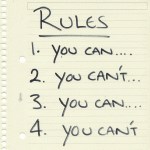 [tweetmeme]You’ve probably started hearing the terms “Gamification” or “Game Mechanics” in increasing frequency in your corporate hallways of late. This is especially so if I’ve been working with you, as Gamification theory and practice (not to be confused with the Economics based “Game Theory”) is quickly becoming a cornerstone of the next generation of highly engaging collaborative Innovation programs.
[tweetmeme]You’ve probably started hearing the terms “Gamification” or “Game Mechanics” in increasing frequency in your corporate hallways of late. This is especially so if I’ve been working with you, as Gamification theory and practice (not to be confused with the Economics based “Game Theory”) is quickly becoming a cornerstone of the next generation of highly engaging collaborative Innovation programs.
I probably get asked about Gamification (aka the application of Game Mechanics/Game Design to a particular system, process, or program) at least once a day now – Spigit has quite the reputation for incorporating Gaming Mechanics into its product design – and the Collaborative Innovation consulting practice I run at Spigit has now also pioneered the development a host of new techniques and methods to apply Game Design techniques into the successful design and execution of various types of challenges, communities and collaborative competitions with some quite astounding results.
Done properly, it’s probably one of the greatest tools in a Social Strategist’s arsenal – giving great insight into that hallowed (and much overused) word “Engagement”. Yet as a topic it’s rarely understood – and even more rarely applied – properly by most including those claiming to be in the field.
First and foremost, let’s tackle some of the misconceptions:
 – Gamification is NOT the same as Social Gaming. Whilst popular games like Farmville, Cityville, etc incorporate gaming techniques and could in themselves be the end result of the Gamification process – Gamification itself is a much bigger subject matter.
– Gamification is NOT the same as Social Gaming. Whilst popular games like Farmville, Cityville, etc incorporate gaming techniques and could in themselves be the end result of the Gamification process – Gamification itself is a much bigger subject matter.
– Gamification IS a Social process
– Gamification IS a design methodology – it’s about how you incorporate Game Mechanics into a system to make it more ENGAGING .
– Gamification is NOT about specific technology features and functions. Buying Bunchball, Badgeville, or any of a host of new companies cashing in on the Gamification trend and blindly incorporating their software into your website does not make you a Gamification King.
The key to comprehending why Gamification is so important to businesses in the future – is understanding that that there is something incredibly and intrinsically addictive about a well-designed game that engages us as humans at the very core of our beings.
At some point in our lives, we’ve all been deeply engrossed in board games, video games, or what have you – looked up at the clock, seen it was 1AM and uttered the words “Crap, how did that happen?”
A good game not only engages us, but it physically and emotionally satisfies a part of us. Left alone we will create games from whatever we have around us (“I spy with my little eye…”).. We actively WANT to, and some might even say need to, play games.
Given options, we will choose to spend time playing games above all other activities We will even PAY to play a good game – and we have whole cities designed to cater to our desire to play games!
What if we could capture the mechanics that make a good game so addictive to us, so engaging, and bring those into a business system that actively creates value for the company? THAT’s the real promise of Gamification.
Games come in many forms though – some very obvious (Monopoly, Blackjack, World of Warcraft. etc) , and others not so (political games, dating games, etc).
In fact, if you think about it – we are actually surrounded by games all around us everyday, although most of the time we don’t necessarily perceive or think of them as being games.
For example – take your morning commute – you get up and leave the house with the aim of getting to work on time. There’s a path to follow, and there are choices along that path:
– Do you decide to drive or to take the train?
– If you drive, which route do you take?
– Do you go the direct route over the hill that can be slower but has less traffic or do you go around on the main road that can be quicker but is more prone to traffic jams?
– How fast do you drive – do you increase your speed when you hit the highway to make up for your lateness but also increase the risk of getting a ticket that would make you even later? (and poorer financially..)
– And so on…
You make decisions and take actions to beat your fellow competitors (other commuters) to get to your ultimate goal – getting to work on time. It is, in essence, a game.
Of course, we don’t associate it as a game because it’s not structured and presented to us as a game – but essentially it has the same structure: A goal, a story, a reason to act, and multiple actions and decisions to get to that goal which ultimately delivers you a reward – in the example above, not getting told off by your boss for being late to work.
Almost everything else you do during your day could also be reframed as a game:
– Lunchtime: When do you leave your desk to avoid the lunchtime rush/get the best grub?
– Airport Security: Which queue do you join to get through as fast as possible and not miss your plane
– Travel – Whom do you fly with? Do you go with the most direct flight, or do you go with the one you fly the most in case you can pull off an elusive upgrade?
– Sales Reporting: What percentage certainty do you report that elusive deal you’ve been working on in your CRM system? Do you raise your boss’s expectation and hope not to disappoint? Or do you low-ball it and aim to surprise?
– At Work: Which order do you attack your workload to be the most efficient with the least amount of pain (and most acclaim from your peers and bosses!)
– At Home: How do you get your child to eat the brussel sprouts that they hate? Cue the airplane game!
Consider that all of these activities you choose to engage in during your day have the same elements as a good game:
– They have a clear start and end to it
– There’s a pay-off for “playing” it well and achieving a “win”
– There’s a clear storyline/reason to play that’s clearly communicated
– A good activity isn’t repetitive
– A good activity doesn’t throw complexity at you all at once, but rather in stages with mini-pay-offs to keep you interested and wanting to “throw the dice” until you finish.
And so on.
We play these games, and we “game” these games (incidentally – people “game” every game out there – given the option of two routes with an equal reward, we will always pick the shortest/easiest route to the prize – maximizing the prize wherever possible), and ultimately we win/lose the games we play.
The problem (or opportunity) with most business systems though, is that, as we don’t envision them as games, we don’t design them as games. That doesn’t make them any less of a game; it just makes them “crappy” games that no one wants to play!
They’re “crappy” for the participants because they’re tedious and unrewarding to play/participate. They’re “crappy” for the business because participation is low or non-existent, compliance to the task at hand is minimal, and because ultimately the system is being gamed for the participants’ benefit and not the company’s benefit.
Instead by building and designing business systems with the mindset that we’re really creating a game, with a specific outcome, and incorporating the same rules and mechanics that naturally engage us in games – we actually end up building a system that is a win-win for all.
 The net effect? Imagine creating systems that are so addictive that people will gladly spend their own free time to participate in something that is adding value to the company – and enjoying the challenges involved in doing so.
The net effect? Imagine creating systems that are so addictive that people will gladly spend their own free time to participate in something that is adding value to the company – and enjoying the challenges involved in doing so.
That they will even give up their own time on the weekends to submit ideas into your innovation system.
Sound impossible? It’s not – we’ve been able to achieve this effect at companies like Citi, Cisco and Houghton Mifflin Harcourt as we applied these new design techniques to the practice of Collaborative Innovation at each of them. More on this to come…
 “Employee Engagement” used to be a term reserved for the hollow halls of HR departments across the land. You’d hear a client say that was their main goal, and you knew a program was doomed to fail – usually because it was code word for “I haven’t got a clue what to do with this type of social application”. My eyes would roll, my sleeves would get rolled up, and I’d get down to work teaching them the need to rethink the requirement for innovation goals that would drive focused value and strategic change through their organization.
“Employee Engagement” used to be a term reserved for the hollow halls of HR departments across the land. You’d hear a client say that was their main goal, and you knew a program was doomed to fail – usually because it was code word for “I haven’t got a clue what to do with this type of social application”. My eyes would roll, my sleeves would get rolled up, and I’d get down to work teaching them the need to rethink the requirement for innovation goals that would drive focused value and strategic change through their organization. Where as yesterday’s employees wanted pool tables and quirky benefits , today’s employees don’t just want to be actively engaged in the company they work for, they DEMAND it.
Where as yesterday’s employees wanted pool tables and quirky benefits , today’s employees don’t just want to be actively engaged in the company they work for, they DEMAND it.
 For example – at Citi, we were able to engage more than 263,000 employees around the world in 97 countries in a collaborative innovation challenge that incorporated Gamification techniques to drive a unique process that collected over 2,300 raw ideas, developed and refined 10 of those into full on business cases with accompanying video pitches, and then further refined those into 4 top quality concepts complete with prototypes that were pitched in front of Citi’s top 5 executives to be funded for development. The amount of collaborative builds was incredible – with each of the top ideas all-receiving input from multiple business units and geographies – something previously unheard of at Citi. And the most amazing part of all? There were zero incentives used to drive that high level of engagement beyond the gamified design of the challenge enabled by the Spigit tool. (You can read more about the
For example – at Citi, we were able to engage more than 263,000 employees around the world in 97 countries in a collaborative innovation challenge that incorporated Gamification techniques to drive a unique process that collected over 2,300 raw ideas, developed and refined 10 of those into full on business cases with accompanying video pitches, and then further refined those into 4 top quality concepts complete with prototypes that were pitched in front of Citi’s top 5 executives to be funded for development. The amount of collaborative builds was incredible – with each of the top ideas all-receiving input from multiple business units and geographies – something previously unheard of at Citi. And the most amazing part of all? There were zero incentives used to drive that high level of engagement beyond the gamified design of the challenge enabled by the Spigit tool. (You can read more about the 







































 Forget about Communities.Don’t do it. Don’t even think about it. Oh I know that communities are all the rage currently – companies are falling over themselves to create, build and own their very own communities: Communities of Employees, Communities of Customers, Communities of Interest Groups, Communities, Communities, Communities….
Forget about Communities.Don’t do it. Don’t even think about it. Oh I know that communities are all the rage currently – companies are falling over themselves to create, build and own their very own communities: Communities of Employees, Communities of Customers, Communities of Interest Groups, Communities, Communities, Communities…. I find that many, maybe even most, companies approach social media, and other online community projects – with very little, if any, forethought on how value will be achieved as a result of jumping on this particular bandwagon.
I find that many, maybe even most, companies approach social media, and other online community projects – with very little, if any, forethought on how value will be achieved as a result of jumping on this particular bandwagon. Unlike in the movie “Field of Dreams” – you can build it – but “they” rarely come spontaneously – or if they do, they may well end up playing a jovial game of scrabble rather than a vintage MLB baseball game on the back lawn.
Unlike in the movie “Field of Dreams” – you can build it – but “they” rarely come spontaneously – or if they do, they may well end up playing a jovial game of scrabble rather than a vintage MLB baseball game on the back lawn. There’s a lot of nice words and feelings in that definition. “A social group”; “common heritage”; “interacting populations”; “shared identity”….The word conjures up a nice warm vision of a collection of friends and associates sitting around a fireside or, for the more cynical among you, images of suburban old age homes in Florida and Arizona maybe.
There’s a lot of nice words and feelings in that definition. “A social group”; “common heritage”; “interacting populations”; “shared identity”….The word conjures up a nice warm vision of a collection of friends and associates sitting around a fireside or, for the more cynical among you, images of suburban old age homes in Florida and Arizona maybe. At the recent
At the recent 
 Thanks to the good people over at HSM, I’ve been invited to take part in the Blogger’s Hub at tomorrow’s
Thanks to the good people over at HSM, I’ve been invited to take part in the Blogger’s Hub at tomorrow’s 

 Having covered all these points admirably,
Having covered all these points admirably,  So it all started with a bit of a joke – I was chatting to moderator-extraordinaire @sourcePOV (Chris Jones’ alias on Twitter to the rest of you) at the end of a particularly well attended #smchat session to brainstorm some ideas for future chat topics (click here to find out more about #smchat). “Hey”, I said with tongue firmly in cheek, “we’ve been talking about social media and web 2.0 for some time now… aren’t we due another point release soon?”…. Chris, with what I’m now realizing is a rather impressive ability to spot an opportunity, quickly managed to convert my offhand quip into a somewhat tenuous agreement to take over from him as moderator for next week’s #smchat gathering, with rather daunting task of leading the 50+ participants through “Qu.20” – figuring out what Web 3.0 is, might be, or would be, if it is anything at all – and then trying to understand the impact on business and beyond.
So it all started with a bit of a joke – I was chatting to moderator-extraordinaire @sourcePOV (Chris Jones’ alias on Twitter to the rest of you) at the end of a particularly well attended #smchat session to brainstorm some ideas for future chat topics (click here to find out more about #smchat). “Hey”, I said with tongue firmly in cheek, “we’ve been talking about social media and web 2.0 for some time now… aren’t we due another point release soon?”…. Chris, with what I’m now realizing is a rather impressive ability to spot an opportunity, quickly managed to convert my offhand quip into a somewhat tenuous agreement to take over from him as moderator for next week’s #smchat gathering, with rather daunting task of leading the 50+ participants through “Qu.20” – figuring out what Web 3.0 is, might be, or would be, if it is anything at all – and then trying to understand the impact on business and beyond.

 Twitter continues to be the fastest growing social media platform at the moment – but that growth seems to be primarily led by individuals with varying degrees of success and sustainability. By now I’m sure you all have several friends who have tried Twitter – some love it, others can’t see the point of it – which doesn’t tend to help its credibility as a business tool.
Twitter continues to be the fastest growing social media platform at the moment – but that growth seems to be primarily led by individuals with varying degrees of success and sustainability. By now I’m sure you all have several friends who have tried Twitter – some love it, others can’t see the point of it – which doesn’t tend to help its credibility as a business tool. The truth of it is that it can be a very valuable tool in your business arsenal – BUT – unlike other social media tools, it delivers little value until you put a significant amount of effort into developing it. Now when I say “developing” – I don’t mean in the classic “programming lines of code” sense – but rather, in order to be useful to a business – you need a defined strategy, and a sustained input from your part before it begins to yield results back. What that input is, and how long it takes you to put in enough input to yield an output, really depends on which of the main strategies you decide to pursue – and as with most applications that work on the establishment of information flows – there are two main strategies: Push and Pull.
The truth of it is that it can be a very valuable tool in your business arsenal – BUT – unlike other social media tools, it delivers little value until you put a significant amount of effort into developing it. Now when I say “developing” – I don’t mean in the classic “programming lines of code” sense – but rather, in order to be useful to a business – you need a defined strategy, and a sustained input from your part before it begins to yield results back. What that input is, and how long it takes you to put in enough input to yield an output, really depends on which of the main strategies you decide to pursue – and as with most applications that work on the establishment of information flows – there are two main strategies: Push and Pull. The Pull strategy for Twitter is simple. It revolves around an understanding that what Twitter can provide to you is an unrivalled personalized information source. Whatever niche information requirements you have – chances are, there are people out there posting tweets on it. Find them, follow them, and eventually your information feed begins to deliver a constant source of valuable data – be it important headlines, links to interesting articles, relevant quotes, allowing you to follow conferences remotely, etc etc – the more careful you are in selecting the people you follow – the more relevant that data feed becomes. In pure Pull strategies – you don’t care how many people follow you – it’s irrelevant and secondary to achieving a quality information flow to your desktop. For those of you considering this strategy – Don Smith has written an excellent
The Pull strategy for Twitter is simple. It revolves around an understanding that what Twitter can provide to you is an unrivalled personalized information source. Whatever niche information requirements you have – chances are, there are people out there posting tweets on it. Find them, follow them, and eventually your information feed begins to deliver a constant source of valuable data – be it important headlines, links to interesting articles, relevant quotes, allowing you to follow conferences remotely, etc etc – the more careful you are in selecting the people you follow – the more relevant that data feed becomes. In pure Pull strategies – you don’t care how many people follow you – it’s irrelevant and secondary to achieving a quality information flow to your desktop. For those of you considering this strategy – Don Smith has written an excellent  The Push strategy is a little more complex – as what you’re trying to do is be read rather than necessarily do the reading. Maybe you’re a company with a product message to distribute, maybe you’re a consultant trying to build up your personal brand, maybe you’re a store with product specials to sell – whatever you are, the basic concept is that you have a message that you want people to see and read. Here, the name of the game is to amass followers – to get the largest possible following to actively subscribe to, and read, your feed. Whilst that sounds easy – it’s far from that – you have two big challenges ahead of you:
The Push strategy is a little more complex – as what you’re trying to do is be read rather than necessarily do the reading. Maybe you’re a company with a product message to distribute, maybe you’re a consultant trying to build up your personal brand, maybe you’re a store with product specials to sell – whatever you are, the basic concept is that you have a message that you want people to see and read. Here, the name of the game is to amass followers – to get the largest possible following to actively subscribe to, and read, your feed. Whilst that sounds easy – it’s far from that – you have two big challenges ahead of you:

 There’s another reason to provide valuable content, especially on Twitter – Twitter is a “viral community”. That is, it works on a viral process of message dissemination to the community at large. You post something of value, I see it, and I “Re-Tweet” it – meaning I pass it on to my own subscriber list with appropriate attribution to the original poster. I get kudos points from my community for passing on something valuable, and you get exposure to my subscriber list who may well decide to subscribe to your postings too (assuming you’ve followed the three steps above to create an interesting profile page!). There’s also exists a general concept of mutual following – You follow me because I post good info, and in return I’ll probably follow you too to see what your feed is like. Of course, if you then post a load of rubbish, I’ll probably end up deleting you from the list of people I follow – but that’s up to you to establish the value to me as a reader 🙂
There’s another reason to provide valuable content, especially on Twitter – Twitter is a “viral community”. That is, it works on a viral process of message dissemination to the community at large. You post something of value, I see it, and I “Re-Tweet” it – meaning I pass it on to my own subscriber list with appropriate attribution to the original poster. I get kudos points from my community for passing on something valuable, and you get exposure to my subscriber list who may well decide to subscribe to your postings too (assuming you’ve followed the three steps above to create an interesting profile page!). There’s also exists a general concept of mutual following – You follow me because I post good info, and in return I’ll probably follow you too to see what your feed is like. Of course, if you then post a load of rubbish, I’ll probably end up deleting you from the list of people I follow – but that’s up to you to establish the value to me as a reader 🙂
 This last week I had the pleasure to attend the World Innovation Forum held in NYC’s Nokia Theatre. Although the conference was well stocked with top class speakers, it wasn’t their content and inspiring speeches that really made the conference noteworthy to me – but rather the attendees – or more specifically, a sub section of the attendees and the conversations that were ongoing throughout the speeches. You see – what made this conference unique, at least to me, is that it was the first conference I’ve been to which has explicitly encouraged and exploited the work of social media mavens during the conference itself.
This last week I had the pleasure to attend the World Innovation Forum held in NYC’s Nokia Theatre. Although the conference was well stocked with top class speakers, it wasn’t their content and inspiring speeches that really made the conference noteworthy to me – but rather the attendees – or more specifically, a sub section of the attendees and the conversations that were ongoing throughout the speeches. You see – what made this conference unique, at least to me, is that it was the first conference I’ve been to which has explicitly encouraged and exploited the work of social media mavens during the conference itself.

 2) The Librarian – The librarian role would primarily be adding supporting material and/or other referenced material from the speaker. Maybe it would be a link to a video shown on screen, or a to a report referenced, or to a list of articles recently authored by the speaker – the end result was a steady flow of material enhancing the content being shared by the speaker that greatly added to the value of the speaker’s talk.
2) The Librarian – The librarian role would primarily be adding supporting material and/or other referenced material from the speaker. Maybe it would be a link to a video shown on screen, or a to a report referenced, or to a list of articles recently authored by the speaker – the end result was a steady flow of material enhancing the content being shared by the speaker that greatly added to the value of the speaker’s talk. 3) The Debater – Focusing more on comments, opinions, and shared viewpoints – the debater added unstructured and less formal contributions, essentially contributing a discussion flow that allowed people to openly support/refute arguments made by the speakers in real time as well as provide a more interactive community experience to the group.
3) The Debater – Focusing more on comments, opinions, and shared viewpoints – the debater added unstructured and less formal contributions, essentially contributing a discussion flow that allowed people to openly support/refute arguments made by the speakers in real time as well as provide a more interactive community experience to the group. Personally I can’t see why all conferences in the future shouldn’t be organized in a similar vein, and I have to take my hat off to HSM Americas, the conference organizer, for taking on such an innovative approach to an Innovation conference. Bearing in mind the buzz created by the invited bloggers to this event, it’s sure to increase interest in attendance next year, and thus benefit them in the long term. The whole effort was also sponsored by Pitney Bowes who definitely got some very positive buzz and attention out of the effort – so well done to them too for a very open minded and innovative approach to attention marketing.
Personally I can’t see why all conferences in the future shouldn’t be organized in a similar vein, and I have to take my hat off to HSM Americas, the conference organizer, for taking on such an innovative approach to an Innovation conference. Bearing in mind the buzz created by the invited bloggers to this event, it’s sure to increase interest in attendance next year, and thus benefit them in the long term. The whole effort was also sponsored by Pitney Bowes who definitely got some very positive buzz and attention out of the effort – so well done to them too for a very open minded and innovative approach to attention marketing. @AndreaMeyer @YourBoot @HelenWalters @georgelevy @Jeffhurt @FHInnovation @dixitboy @innovate @chrisflanagan @ReneeCallahan @katiekonrath @stu @stevetodd @ssusman @bhc3 @twinnovator @ctcoco @pinnovation @PBConnect @wearewhatif @vidales @wrighth1 @hsmamericas @lindegaard @donpeppers @Pauldunay @dominicbasulto @LeftTheBox @Stu and of course, if you’re not already following me on @bpluskowski, shame on you :p
@AndreaMeyer @YourBoot @HelenWalters @georgelevy @Jeffhurt @FHInnovation @dixitboy @innovate @chrisflanagan @ReneeCallahan @katiekonrath @stu @stevetodd @ssusman @bhc3 @twinnovator @ctcoco @pinnovation @PBConnect @wearewhatif @vidales @wrighth1 @hsmamericas @lindegaard @donpeppers @Pauldunay @dominicbasulto @LeftTheBox @Stu and of course, if you’re not already following me on @bpluskowski, shame on you :p



